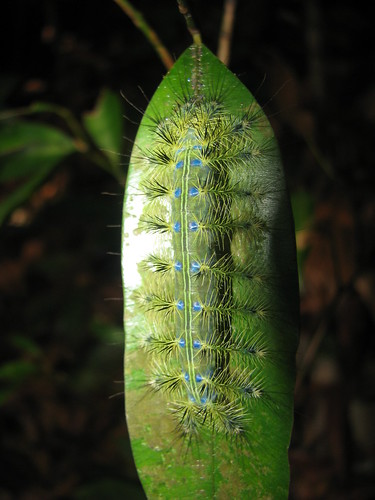Today me and RY had the opportunity to guide a class from Clementi Town Secondary School after several postponing due to weather conditions.
Going through South View Path, we saw many Gutta Percha (Palaquium gutta) with their characteristic golden underside leaves. These plants have a sticky white sap that is being used as a material in dental fillings due to its inert nature. In the 1900s, many flora were destroyed in the attempt to harvest this plant in order to make insulation cables for submarine lines.
A huge woody climber hanged just across the pathway. Also known as lianas, these plants serve as connectors for many animals like squirrels to move between the trees. However, the unfortunate thing is that if one fell, it will drag down all the other trees that are entwined with it.
The best find of the day: One of the students spotted a huge caterpillar just under a St. Andrew's cross spider! It is a caterpillar of the butterfly, Yellow Archduke (Lexias canescens).
This tall Red Dhoop (Parishia insignis), is named as a heritage tree. This is a program started by Nparks to conserve our mature trees. They are given regular inspection and pruning. Even lightning conductors are installed to protect them against lightning strikes.
The presence of Terentang (Campnosperma auriculata) gave an indication that we are within a disturbed forest as this a tree that is found in a mature secondary forest. The leaves are very distinctive, having a folded pair of "ear-lobes" near the leaf stalk.
This is a very common tree in Bukit Timah and it is also the name of one of our housing estate. The wood of the Tampines tree (Streblus elongatus) is very hard and tough, thus they are used to make tool handles.
The leaf litter plant (Agrostistachys longifolia) has an interest way of getting additional nutrients. Its rosette arrangement of leaves (monopodial branching) helps to trap dead litter between the leaves and they will eventually decompose and obtain the necessary nourishment since the forest floor is very nutrient poor.
The Singapore fern (Tectaria singaporeana) like all ferns, produce tiny spores that allow effective wind dispersal. However, not all the leaves have spores. Only the mature ones will have them on their undersides. Its Malay name is called Paku Biawak, or the Monitor Lizard Fern.
The nutmeg (Myristica sp.) is easily identifiable by the leaf branches which spread out like the spokes of a wheel. Nutmegs are dispersed by birds like pigeons and hornbills, which are becoming rare in the forest. Without these agents, they risked overcrowding and competiton for resources if they all grow in the same vicinity.
This is another species of fern, known commonly as the centipede fern (Blechum orientale). Why? Because the young fronds of these plants actually look just like centipedes!
Turning up to Kruing path, we saw the huge Seraya tree which indicates the presence of a primary rainforest. These huge dipterocarps are an important source of quality timber, also known as meranti in the timber trade.
Anyway, flipping over a dead log found there, I showed the students a termite nest. Termites are actually not very closely related to ants. They do not undergo complete metamorphosis like ants but just having a nymph stage, skipping the larvae and pupae stage all together. They also do not have a distinct separation of their thorax and abdomen like ants, which have a clear "pinched waist".
One of my sharp-eyed students spotted another great find for us. A giant forest ant (Camponotus gigas) nest! These ants usually hunt in small groups or individually so this is indeed a rare sight for me.
This is not the common black house crow that we see in our urban estates. Instead, the Greater racket-tailed drongo (Dicrurus paradiseus) is a forest dwelling bird that have two long feathers extending from the tail. They are also a great mimic of other bird calls.
And of course, the trip will not be complete without the ant plant (Macaranga bancaca). The heart gaster ants (Crematogaster sp.) lives in the hollow stem and feed on the fat-rich globules found within the dark red stipules. In return, they fend off herbivores or other smothering climbers.
Finishing the walk, we had some time to head towards Hindhede Quarry where granite used to be mined. A troop of long-tailed macaques (Macaca fascicularis) were basking at the railings and many juveniles were hanging on to their mum or playing about.
We also managed to see other animals like a stick insect, a jumping spider eating a fly and two clouded monitor lizards (Varanus bengalensis). In fact, one jumped out from the shrubs in front of a student, scaring the life out of her ;p. Unfortunately, I was always engrossed when guiding and usually forget to take photos to blog. A good and eventful day nevertheless I must say, with a bunch of enthusiastic and attentive students who managed to bear with their hunger pangs and spotted lots of animals for me along the way.




5 comments:
The Singapore fern like all ferns, produce tiny spores that allow effective wind dispersal.
This sentence sounds so funny... well the first half...
Very beautiful monkeys. Nice photo. :)))
Thanks!
nutmeg is not an ingredient in MDMA. Nutmeg contains myristicin, a weak monoamine oxidase inhibitor. In low doses, nutmeg produces no noticeable physiological or neurological response. Large doses can be dangerous (potentially inducing convulsions, palpitations, nausea, eventual dehydration, and generalized body pain). In large amounts it is reputed to be a strong deliriant. Users report both negative and positive experiences, involving strong open-eye-visuals (hallucinations), and in some cases quite severe anxiety. Users may feel a sensation of blood rush to the head, or a strong euphoria and dissociation. - wiki
Oh Gosh, u are right. I wonder where did I get this information from...
Thanks for the tip!
Post a Comment